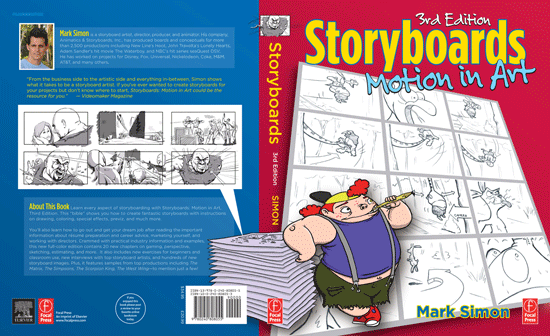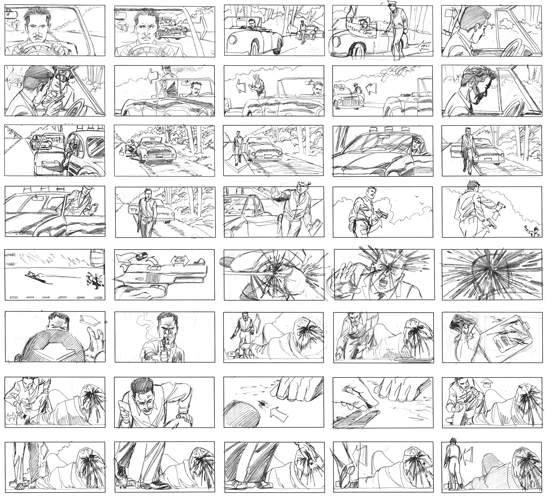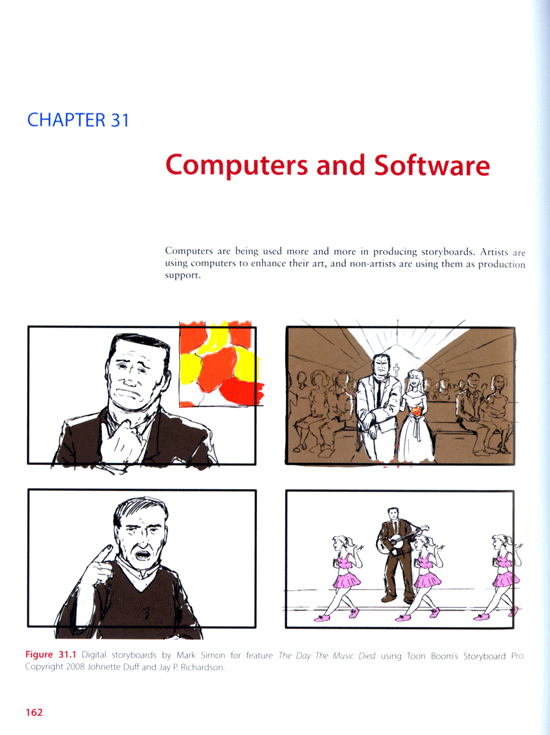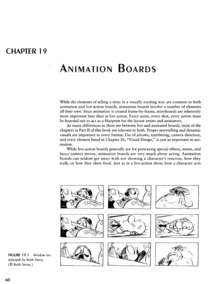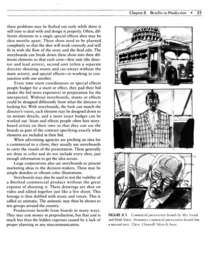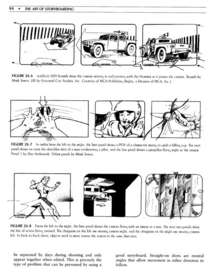Motion In Art – 3rd Edition
- Home
- Motion In Art – 3rd Edition
Storyboards: Motion In Art – 3rd Edition is a step-by-step breakdown of the drawing, production and business of storyboards, discussing in detail what storyboards are, how and why they are used, and how to get started and flourish as a storyboard artist. Using new exercises, new interviews, real-life examples of working in the entertainment industry, and many sample drawings, this book teaches you how to:
- Develop and improve your boards
- Work with directors
- Sketch boards
- Color boards
- Develop your resume and portfolio
- Market your talent
- Use computers to create and improve a storyboard
- Boards for gaming
A new multi-artist storyboard experiment shows how different artists interpret the same scene, allowing readers to compare the different visions each artist can bring to a production. Storyboard samples show rare glimpses into the hidden production of some favorite films and tv shows.
- Over 20 new chapters
- 1,100 new images
- 380 pages
- Now in full COLOR.
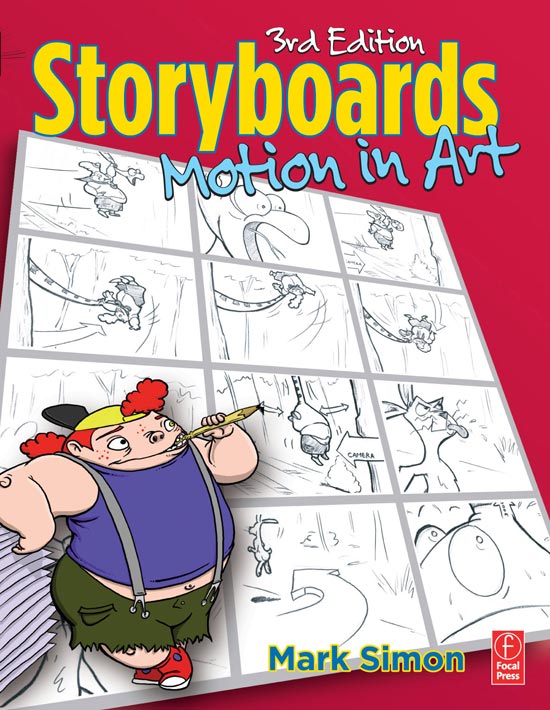
Now Available On Kindle
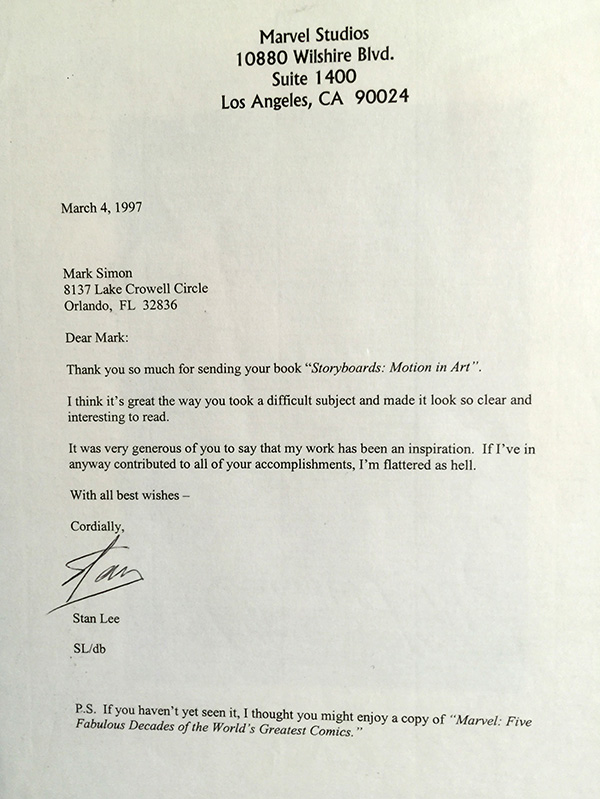
Stan Lee, yes THAT Stan Lee, loves my book on storyboarding. Check out this letter I got from him.
Table of Contents
Introduction
Acknowledgments
Preface
Chapter 1 – What Are Storyboards?
Preface
Chapter 1 – What Are Storyboards?
Part One – Getting Started
Chapter 2 – Getting Started
Chapter 3 – What It Takes to Be a Storyboard Artist
Chapter 4 – Education
Chapter 5 – Materials
Chapter 6 – Benefits to Production
Chapter 3 – What It Takes to Be a Storyboard Artist
Chapter 4 – Education
Chapter 5 – Materials
Chapter 6 – Benefits to Production
Part Two – The Art Of Storyboarding
Chapter 7 – Drawing Quick Thumbnail Storyboards
Chapter 8 – Sketching Perspective
Chapter 9 –Final Storyboard Art and Clean-up
Chapter 10 – Storyboard Coloring
Chapter 11 – Presentation Boards versus Production Boards
Chapter 12 – Live-Action Boards
Chapter 13 – Animation Boards
Chapter 14 – Gaming And Multimedia Boards
Chapter 15 – Live-Event and Theme-Park Boards
Chapter 16 – Laser-Show Boards
Chapter 17 – Comps
Chapter 18 – Animatics
Chapter 19 – Previz
Chapter 20 – Styles
Chapter 21 – Directing Shots
Chapter 22 – Working with Directors
Chapter 23 – Screen Direction
Chapter 24 – Staging and Composition
Chapter 25 – References and Research
Chapter 26 – Illustrated Camera Techniques
Chapter 27 – Numbering
Chapter 28 – Contrast and Mood
Chapter 29 – Special Effects
Chapter 30 – Conceptual Illustration
Chapter 31 – Computers and Software
Chapter 32 – Tricks of the Trade
Chapter 33 – Presentation and Delivery
Chapter 8 – Sketching Perspective
Chapter 9 –Final Storyboard Art and Clean-up
Chapter 10 – Storyboard Coloring
Chapter 11 – Presentation Boards versus Production Boards
Chapter 12 – Live-Action Boards
Chapter 13 – Animation Boards
Chapter 14 – Gaming And Multimedia Boards
Chapter 15 – Live-Event and Theme-Park Boards
Chapter 16 – Laser-Show Boards
Chapter 17 – Comps
Chapter 18 – Animatics
Chapter 19 – Previz
Chapter 20 – Styles
Chapter 21 – Directing Shots
Chapter 22 – Working with Directors
Chapter 23 – Screen Direction
Chapter 24 – Staging and Composition
Chapter 25 – References and Research
Chapter 26 – Illustrated Camera Techniques
Chapter 27 – Numbering
Chapter 28 – Contrast and Mood
Chapter 29 – Special Effects
Chapter 30 – Conceptual Illustration
Chapter 31 – Computers and Software
Chapter 32 – Tricks of the Trade
Chapter 33 – Presentation and Delivery
Part Three – The Business Of Storyboarding
Chapter 34 – Résumés
Chapter 35 – Portfolios
Chapter 36 – Education and Skills
Chapter 37 – How I Got Started
Chapter 38 – Who Hires Storyboard Artists?
Chapter 39 – Finding a Job
Chapter 40 – Prepping for Each Job
Chapter 41 – How Productions Work
Chapter 42 – What Producers Look For
Chapter 43 – Pricing
Chapter 44 – Estimating
Chapter 45 – Billing Practices
Chapter 46 – Licensing
Chapter 47 – Trade Practices
Chapter 48 – Format
Chapter 49 – Agents and Artist Reps
Chapter 50 – Unions
Chapter 51 – Business Aspects
Chapter 35 – Portfolios
Chapter 36 – Education and Skills
Chapter 37 – How I Got Started
Chapter 38 – Who Hires Storyboard Artists?
Chapter 39 – Finding a Job
Chapter 40 – Prepping for Each Job
Chapter 41 – How Productions Work
Chapter 42 – What Producers Look For
Chapter 43 – Pricing
Chapter 44 – Estimating
Chapter 45 – Billing Practices
Chapter 46 – Licensing
Chapter 47 – Trade Practices
Chapter 48 – Format
Chapter 49 – Agents and Artist Reps
Chapter 50 – Unions
Chapter 51 – Business Aspects
Part Four – Interviews
Chapter 52 – Alex Saviuk: Storyboard Artist/Comic Book Artist
Chapter 53 – Mark Moore: ILM Vice President, Senior Executive in Charge of Production, and Former Storyboard Artist
Chapter 54 – Sean Cushing: Executive Producer, Pixel Liberation Front
Chapter 55 – Josh Hayes: Director/Producer/Storyboard Artist/Art Director
Chapter 56 – Tim Burgard: Storyboard Artist
Chapter 57 – Woody Woodman: Animated Feature Film Storyboard Artist
Chapter 58 – Lyle Grant: Commercial Storyboard Artist
Chapter 59 – Jeff Dates: Creative Director of Janimantion
Chapter 54 – Sean Cushing: Executive Producer, Pixel Liberation Front
Chapter 55 – Josh Hayes: Director/Producer/Storyboard Artist/Art Director
Chapter 56 – Tim Burgard: Storyboard Artist
Chapter 57 – Woody Woodman: Animated Feature Film Storyboard Artist
Chapter 58 – Lyle Grant: Commercial Storyboard Artist
Chapter 59 – Jeff Dates: Creative Director of Janimantion
Part Five – Exercises
Chapter 60 – Exercise 1: Dogfight
Chapter 61 – Exercise 2: High Fall
Chapter 62 – Exercise 3: Outlines
Chapter 63 – Exercise 4: Special Effects Matte Shots
Chapter 64 – Exercise 5: TV Western
Chapter 65 – Exercise 6: Commercial
Chapter 66 – Exercise 7: Animation/Cartoon
Chapter 61 – Exercise 2: High Fall
Chapter 62 – Exercise 3: Outlines
Chapter 63 – Exercise 4: Special Effects Matte Shots
Chapter 64 – Exercise 5: TV Western
Chapter 65 – Exercise 6: Commercial
Chapter 66 – Exercise 7: Animation/Cartoon
Part Six – Experiment
Chapter 68 – Experiment
Part Seven – Appendices
Forms
Resources
“How to Draw” Books
“Making of” Books
“Art of” Books
Special Effects
The Screenplay
Animation
Online References
Reference Books
Storyboarding/Directing
Marketing
Architecture and Interiors
Periodicals
Resource Guides
Resources
“How to Draw” Books
“Making of” Books
“Art of” Books
Special Effects
The Screenplay
Animation
Online References
Reference Books
Storyboarding/Directing
Marketing
Architecture and Interiors
Periodicals
Resource Guides
Part Eight – Storyboard Samples
Glossary
Index
Index
Photo Gallery
Testimonials
Storyboard Forms.
You can request FREE storyboard forms here. There are 25 total files in the ZIP file which will be sent to you. Of those, there are 5 different storyboard forms, each saved in 4 different formats: AI (Adobe Illustrator), CDR (CorelDRAW 10), JPG and PDF. The TV Storyboard Form – 3 up is also included as a PSD (Adobe Photoshop) file with all the levels pre-built for you. You can use this as a template to make PSDs of the other formats if you wish. Also included is a Storyboard Invoice in three formats. The last file is a TXT file containing the text of this message. If you don’t see a form below, you may have to turn off your browsers pop-up blocker.
Please fill out this brief form and the storyboard forms and files you requested will be sent to you immediately.




